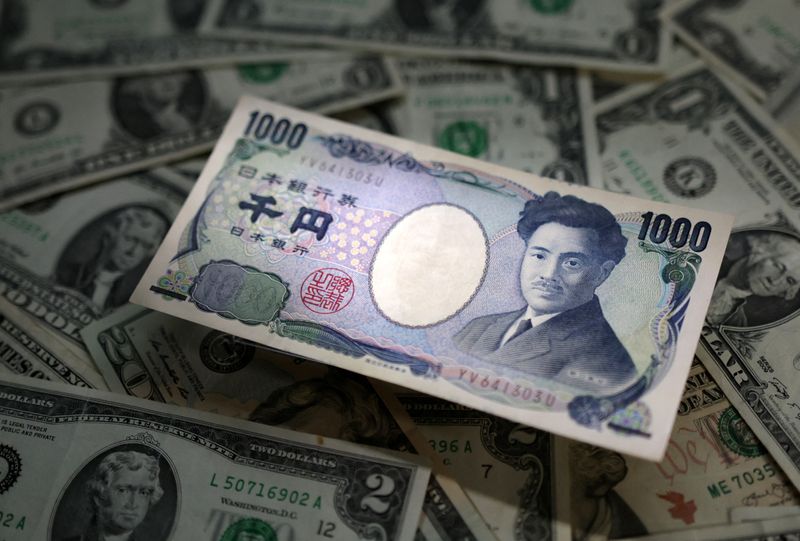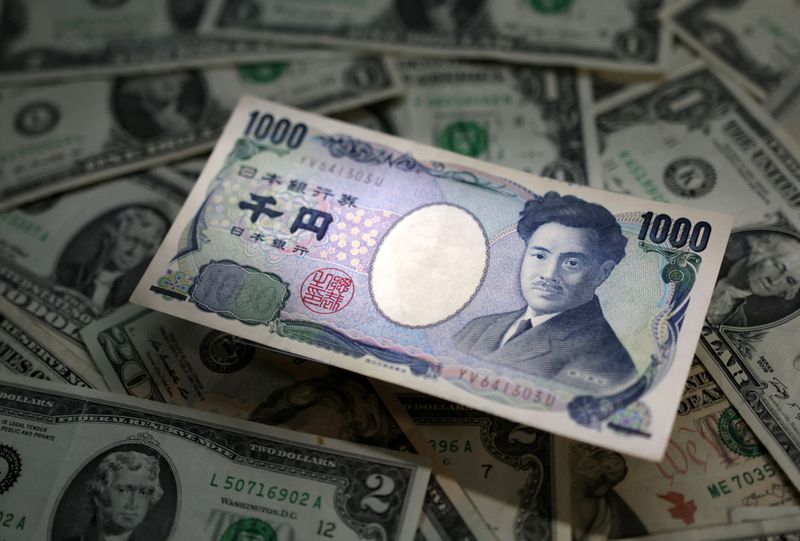Forex
Yen drops to 15-year low vs euro on BOJ’s policy tweak


© Reuters. FILE PHOTO: Japanese Yen and U.S. dollar banknotes are seen in this illustration taken March 10, 2023. REUTERS/Dado Ruvic/Illustration/File Photo
By Gertrude Chavez-Dreyfuss and Joice Alves
NEW YORK/LONDON (Reuters) – The yen slumped across the board on Tuesday, dropping to a fresh 15-year low against the euro and a new one-year trough versus the dollar, after a small step by the Bank of Japan (BOJ) toward ending years of monetary stimulus failed to appease some investors who had expected a bigger move.
The Japanese unit also fell against sterling, the Swiss franc, and the Australian dollar.
At the conclusion of its two-day policy meeting, the BOJ further loosened its grip on long-term interest rates by tweaking its bond yield control policy again, taking another small step towards dismantling its controversial monetary stimulus of the past decade.
BOJ said it would keep the 10-year government bond yield around 0% set under its yield curve control (YCC), but re-defined 1.0% as a loose “upper bound” rather than a rigid cap.
It also removed a pledge to defend the level with offers to buy unlimited amounts of bonds.
The euro jumped to a 15-year high against the Japanese currency of 160.84 yen, and was last up 1.3% at 160.20 yen.
The yen slid to 151.20 against the dollar, a fresh one-year low as traders focused on the BOJ’s dovish pledge to “patiently” maintain accommodative policy and forecast inflation would drop back below 2% in 2025. The dollar was last up 1.4% at 151.07 yen.
The Japanese yen had risen to a two-week high on Monday on a report that the BOJ would tweak its yield curve control policy, prompting market participants to believe that the BOJ would do more.
“Markets are disappointed with the Bank of Japan’s muddled messaging and indecisive policy direction,” said Karl Schamotta, chief market strategist at Corpay in Toronto.
“By moving to a reference point and failing to scrap the yield cap outright, policymakers maintained ambiguity around where and why they might intervene in bond markets, and lessened the likelihood of a wider surge in repatriation flows.”
HIGHER RATES FOR LONGER
In the United States, U.S. data continued to depict a resilient economy.
U.S. labor costs increased solidly in the third quarter amid strong wage growth, data showed, the latest indication that the Federal Reserve could keep interest rates high for some time. The Employment Cost Index (ECI), the broadest measure of labor costs, rose 1.1% last quarter after increasing 1.0% in the April-June period.
Another piece of data indicated that U.S. annual home price growth accelerated for a third straight month in August, underscoring the recovery of the housing market after a period of softening.
Home prices rose 5.6% on a year-over-year basis in August, up from a 4.6% increase in the prior month, the Federal Housing Finance Agency (FHFA) said.
Fed officials were due to start a two-day policy meeting on Tuesday. The Fed is expected to leave interest rates unchanged but maintain its hawkish stance at the conclusion of that meeting, given that the surge in U.S. Treasury yields and the stock market sell-off have tightened financial conditions.
The was last up 0.3% at 106.43.
While the index looked set to end the month broadly unchanged, analysts say the dollar remains underpinned by risks of another rate hike from the Fed, noting a still-resilient U.S. economy.
“The Fed can still have the luxury of sounding hawkish in its outlook, by stressing the ‘high for long’ narrative,” said Thierry Wizman, Macquarie’s global FX and interest rates strategist.
In other currencies, sterling was down 0.2% at $1.2141 ahead of an interest rate decision by the Bank of England later in the week where expectations are also for the central bank to stand pat.
========================================================
Currency bid prices at 10:37AM (1437 GMT)
Description RIC Last U.S. Close Pct Change YTD Pct High Bid Low Bid
Previous Change
Session
Dollar index 106.4700 106.1600 +0.31% 2.880% +106.5600 +105.8900
Euro/Dollar $1.0604 $1.0616 -0.11% -1.04% +$1.0675 +$1.0591
Dollar/Yen 151.1050 149.0500 +1.38% +15.25% +151.1850 +149.0300
Euro/Yen 160.23 158.20 +1.28% +14.21% +160.8400 +158.2100
Dollar/Swiss 0.9065 0.9019 +0.53% -1.95% +0.9074 +0.9010
Sterling/Dollar $1.2138 $1.2168 -0.23% +0.38% +$1.2200 +$1.2127
Dollar/Canadian 1.3874 1.3827 +0.35% +2.41% +1.3877 +1.3815
Aussie/Dollar $0.6331 $0.6374 -0.66% -7.12% +$0.6375 +$0.6328
Euro/Swiss 0.9610 0.9572 +0.40% -2.88% +0.9624 +0.9558
Euro/Sterling 0.8733 0.8720 +0.15% -1.26% +0.8753 +0.8722
NZ $0.5816 $0.5844 -0.47% -8.39% +$0.5857 +$0.5814
Dollar/Dollar
Dollar/Norway 11.1720 11.1420 +0.55% +14.15% +11.2040 +11.1320
Euro/Norway 11.8479 11.8160 +0.27% +12.90% +11.8840 +11.8160
Dollar/Sweden 11.1513 11.1378 +0.00% +7.14% +11.1801 +11.0858
Euro/Sweden 11.8251 11.8254 +0.00% +6.06% +11.8434 +11.8077

 Forex3 years ago
Forex3 years agoForex Today: the dollar is gaining strength amid gloomy sentiment at the start of the Fed’s week

 Forex3 years ago
Forex3 years agoUnbiased review of Pocket Option broker

 Forex3 years ago
Forex3 years agoDollar to pound sterling exchange rate today: Pound plummeted to its lowest since 1985

 Forex3 years ago
Forex3 years agoHow is the Australian dollar doing today?

 Cryptocurrency3 years ago
Cryptocurrency3 years agoWhat happened in the crypto market – current events today

 World3 years ago
World3 years agoWhy are modern video games an art form?

 Commodities3 years ago
Commodities3 years agoCopper continues to fall in price on expectations of lower demand in China

 Economy3 years ago
Economy3 years agoCrude oil tankers double in price due to EU anti-Russian sanctions





















